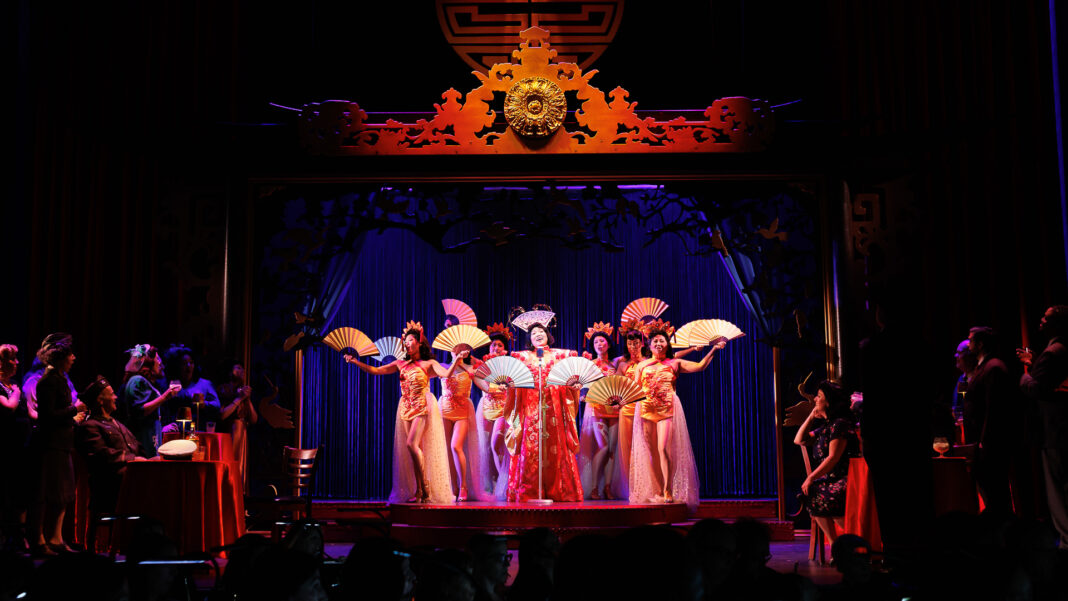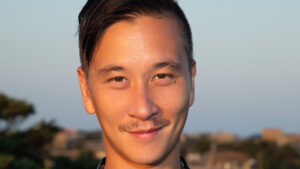
Musicals, operas and plays are regularly being reimagined. The recent production of Oklahoma! on Broadway; Michael Mayer’s production of Rigoletto at the Metropolitan Opera and the production of King Lear in which Glenda Jackson starred as Lear are just three examples. Enter director Phil Chan with Boston Lyric Opera‘s production of Puccini’s Madama Butterfly.
For the uninitiated, Madama Butterfly tells the story of Cio-Cio San, a young Japanese girl who falls in love with a US Naval officer named Pinkerton.
Unbeknownst to Pinkerton, she has a baby – his baby. Unbeknownst to Cio-Cio San, he’s gotten married.
Chan has changed the setting of this tragic story to 1940s San Francisco – before the Japanese bombing of Pearl Harbor. If you know your history you know that soon after that 120,000 Japanese Americans were interred in concentration camps in America – not for being the enemy, but for looking like they could be the enemy. Cio-Cio San (Karen Chia-Ling Ho) is now a nightclub entertainer named Butterfly. Pinkerton (Dominick Chenes) is about to be shipped out to war as a result of the bombing.
It’s a bold decision, but there is so much more to Chan’s thinking as I learned when we spoke last week before Madama Butterfly opened. What follows are excerpts from our conversation that have been edited for length and clarity. To see the full interview with Chan, please go to our YouTube channel.
Q: What is it about this story that you think resonates so strongly and so deeply with people?
I think it really comes from the music. Puccini has written such a beautiful opera with such strong musical characters, such emotional highs and lows. Why does one like one roller coaster over the other roller coaster? It’s the feeling of butterflies, both extreme joy and relief, and then utter despair. You just ride between those two emotions for most of the opera.

It’s always been sort of a controversial opera. In the forties, it was actually canceled for a little bit. Canceled because people were afraid that it was empathizing with Japanese people too much. Now it’s again undergoing another sort of canceling because of its rightly poor depictions of Asian people. Caricature depictions. What it reinforces about Asian women.
We’re also having a second look at this opera, especially in the light of this anti-Asian social hysteria that has come out since COVID. It showed us that our acceptance of Asian-Americans here is really just a very thin veneer, the smallest thing, and we are not accepted here anymore.
When and where did you first experience Madama Butterfly?
I probably first saw it at The Met the current production [by Anthony Minghella], which is beautiful. I think I saw it before I had much of an awareness of any of this advocacy; how we represent Asian people. I saw it as just another fantasy that was told in the dramatic way, just like there are stories that take place in Germany and other places.
But then I started to dig a little bit deeper. The way we do things in opera and ballet that we’ve inherited from Europe that don’t necessarily serve everyone. These stories have power and they’re telling us specific narratives over and over again at the expense of Asian-American voices. What do they reinforce and what do they tell us – works like Madama Butterfly, this hyper-sexual, hyper-submissive Asian woman? You know what happens when we see that on stage?
In reality Asian women are being pushed onto subways tracks and and followed home and stalked home and shot down at their places of work, blamed for a disease. How are those two things connected when the arts are a way to empathize with the other? What if our arts aren’t doing us that favor anymore because the power depicting them is from 100 plus years ago?If we want this work to still have resonance, we need to help clear away some of the 100 years of cultural baggage so that Puccini’s intentions can be kept pure. So that’s what we I tried to do with this piece.
Is there something to learn by seeing how previous generations presented themselves, others and how they presented stories? Is there something to learn from those mistakes that should allow for them to exist in spite of their flaws, in spite of these depictions that are not appropriate?
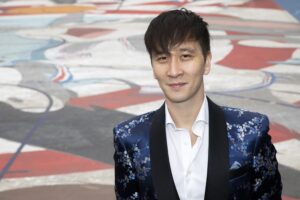
I think there’s a difference between static art forms like photography, painting, sculpture, film and the performing arts which are living art forms. The static art forms [we] need to keep them as that is right. Birth of a Nation is arguably a great American film. It’s also a very problematic film. But we need to keep it alive and look at it within a context of where it belongs, which is in a museum to understand how it changed the minds of our people in a dangerous way.
With the performing arts, however, we have a different set of rules. The performing arts have to be a mirror to our current moment. They have to reflect who we are and of our time. And if those things don’t hold true, the art isn’t honest. It doesn’t have integrity. Think about Shakespeare. If you’ve ever seen a Shakespearean play with a woman in it, you’re already seeing something radical and very different. The reason we’ve done that is because we need the art to better reflect our times. It’s by reimagining that we get to keep these works alive.
What I’m saying is let’s use our creative imagination. Let’s imagine this music with a bigger story for more people. Then let’s use that money we make from Butterfly ticket sales to commission a female composer or a Black composer or an Asian composer who’s alive now to make new work that reflects us so we can contribute to the canon as well. That’s also the bigger picture that I’m hoping this process brings out.
Anybody who tackles a story that has suicide in it, as this one famously does, as a director, is Cio-Cio San (or Butterfly’s) suicide an act of bravery or not?
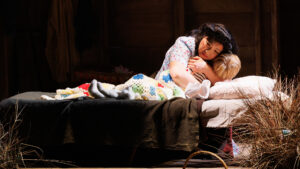
That depends on if the character kills herself. I think we’re questioning some of these stories. So just making the assumption that Cio-Cio San kills herself, again, goes against this. What else could it be? I’m not going to give away our ending, but just asking that question. The character does have to die at the end. But what is another death that we all experience? Or is there a death that is different than an automatic ritual suicide? What is a death that everybody can feel that isn’t just this abstract other thing that we don’t do in our society because we’re not crazy Japanese people who would even do that?
Suicide doesn’t mean what it meant in the context of this opera when [Puccini] wrote the opera. So that is something that modern directors have to deal with. I think that’s why we’re seeing so much diversity in how this opera ends, which I think is really exciting. It keeps audiences guessing and keeps them wanting to come back and see this story over and over again.
I saw a production that Josh Shaw of Pacific Opera Project did of Madama Butterfly, where all the Japanese characters sung in Japanese and all the the American characters sung in English. The idea was that these are barriers that they would have to have faced in the real world of Madama Butterfly. Do you think this opera lends itself to more dynamic changes than other operas?
In my research, it’s the Orientalist repertory that is almost the hardest to re-imagine because we love the fantasy. Orientalism has been a vehicle for spectacle for so long. Can you imagine The Met’s Turandot as anything but this giant Peking Opera spectacle? It’s just so big. It’s so beloved. It’s so pretty. It’s beautiful. It’s problematic, but it’s beautiful, right?You want that perfume. It’s very attractive. The problem is it doesn’t hold water when we are diverse. So when you’re looking at an otherwise outside culture as an insider and going, I’m Japanese and that’s not what we look like. Or I’m Chinese – I don’t see myself in this at all. It’s a very disorienting experience. But it was not made for us. So I think the Oriental operas are the hardest to re-imagine and balance because we’re stuck in how it’s done.
You mentioned the hysteria whipped up because of COVID and the resulting anti-Asian violence. Let’s assume that this production is successful in Boston and has a life beyond Boston in other cities. What is your hope that this production of Madama Butterfly will do to change the minds of the kind of people who spat on you and made it difficult for your father to go out*?
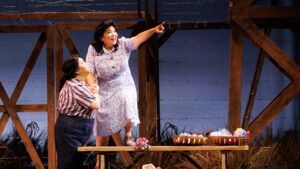
I think art is a way to bridge differences between people. Empathy and music is a way to cut through people’s hearts. It cuts through all of the vulnerabilities of the walls. It goes right to your heart. Puccini was very good at that. This way of doing the opera is a way to build empathy for Asian people. A way to say, we are not going to do this again to anybody. We’re not going to do this to Japanese Americans. We’re not going to do it to Jewish people. We’re not going to do it to Black people. We’re not going to do this again to anybody.
If that can be part of the story we can win over hearts, not just minds. It’s not an intellectual debate we’re having. It’s an emotional one. Art is a way to get people to see each other. Man, if you saw me as a real person, you wouldn’t spit on me. So let me give you some good music to help you to see me. I think that’s what this has the potential to do.
Madama Butterfly continues at Boston Lyric Opera with performances on Friday, September 22nd and Sunday, September 24th.
*To see the full context of that question and the full and fascinating conversation with Phil Chan, please go here.
Main Photo: Karen Chia-Ling Ho and company in Madama Butterfly at Boston Lyric Opera directed by Phil Chan (Photo by Ken Yotsukura/Courtesy Boston Lyric Opera)











